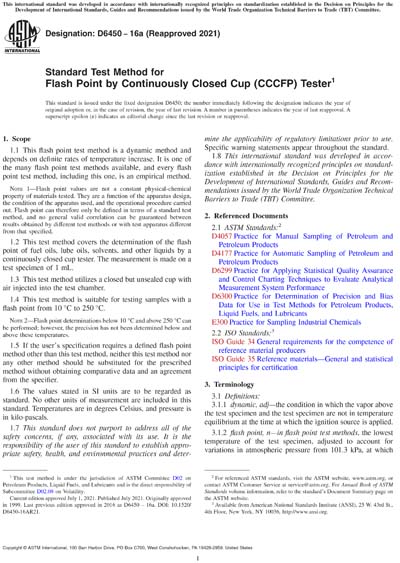Most recent
ASTM D6450-16a(2021)
Standard Test Method for Flash Point by Continuously Closed Cup (CCCFP) Tester
1.1This flash point test method is a dynamic method and depends on definite rates of temperature increase. It is one of the many flash point test methods available, and every flash point test method, including this one, is an empirical method.
Note 1:Flash point values are not a constant physical-chemical property of materials tested. They are a function of the apparatus design, the condition of the apparatus used, and the operational procedure carried out. Flash point can therefore only be defined in terms of a standard test method, and no general valid correlation can be guaranteed between results obtained by different test methods or with test apparatus different from that specified.
1.2This test method covers the determination of the flash point of fuel oils, lube oils, solvents, and other liquids by a continuously closed cup tester. The measurement is made on a test specimen of 1 mL.
1.3This test method utilizes a closed but unsealed cup with air injected into the test chamber.
1.4This test method is suitable for testing samples with a flash point from 10 °C to 250 °C.
Note 2:Flash point determinations below 10 °C and above 250 °C can be performed; however, the precision has not been determined below and above these temperatures.
1.5If the user's specification requires a defined flash point method other than this test method, neither this test method nor any other method should be substituted for the prescribed method without obtaining comparative data and an agreement from the specifier.
1.6The values stated in SI units are to be regarded as standard. No other units of measurement are included in this standard. Temperatures are in degrees Celsius, and pressure is in kilo-pascals.
1.7This standard does not purport to address all of the safety concerns, if any, associated with its use. It is the responsibility of the user of this standard to establish appropriate safety, health, and environmental practices and determine the applicability of regulatory limitations prior to use. Specific warning statements appear throughout the standard.
1.8This international standard was developed in accordance with internationally recognized principles on standardization established in the Decision on Principles for the Development of International Standards, Guides and Recommendations issued by the World Trade Organization Technical Barriers to Trade (TBT) Committee.
ASTM International [astm]

